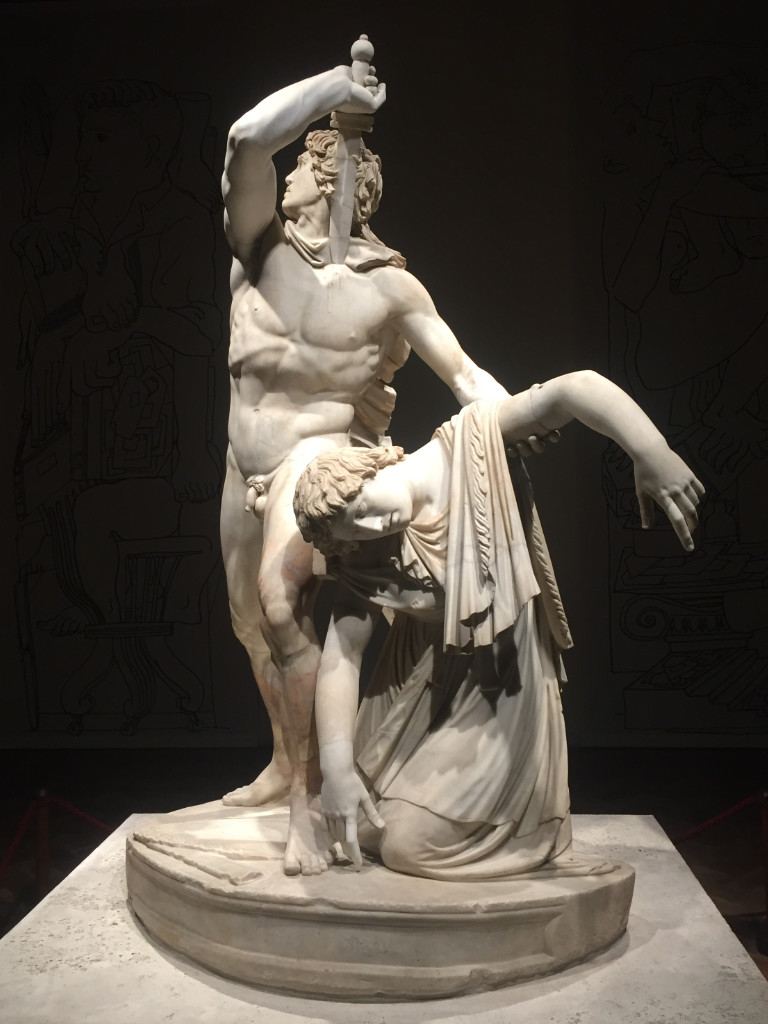The National Roman Museum
The National Roman Museum is one of the most important archaeological museums in the world, but it’s almost unknown to the general public. For this reason, it’s one of the best Rome Off-the-beaten-path sights.
Its collection is hosted in four different buildings, that you can visit with one ticket:
- Palazzo Massimo
- Baths of Diocletian
- Palazzo Altemps
- Crypta Balbi
1. Palazzo Massimo.
This beautiful palace near Termini train station is one of the most interesting and underrated museums in Rome. Despite its importance and size, it’s almost always empty, and even accessible in a wheelchair very easily.

Among the many masterpieces that you can see if you visit it, it’s worth citing:
- Augustus of Prima Porta. It’s an iconic statue of the first Roman emperor, Augustus, which you can see in almost any book about Roman art.
- The Imperial Insignia of Maxentius. The ONLY original ancient Roman imperial insignia that survived until nowadays. Among them, you can see the scepter of the emperor and other unique items.
- The Boxer. A moving, original ancient Greek bronze statue representing a boxer at rest.
- The Hellenist Prince. Another beautiful ancient Greek statue representing a monarch in heroic nudity
- Frescoes from the Villas of Livia and Farnesina. Original ancient Roman frescoes from villas that belonged to the wife and the daughter of the emperor Augustus.
- Lots of colorful mosaics.
- An ancient Roman mummy of a young girl.
- The Sarcophagus of Portonaccio. A marvelous, intricate ancient Roman sarcophagus representing a general in battle.
These are only some of the many masterpieces that you can admire, in total peace, in Palazzo Massimo.
2. Baths of Diocletian

The Baths of Diocletian are the biggest Roman baths in the world.
You can walk through the hot rooms where the Romans used to relax, see the gorgeous marble decoration and the impressive ceilings, and have a deeper understanding of daily life in ancient Rome.
The Baths of Diocletian also host a very nice museum, where you can find lots of interesting ancient Roman artifacts and prehistorical items from around Rome.
You can also visit the Cloister of the Basilica of Santa Maria degli Angeli, designed by Michelangelo.
You don’t need a ticket to see, instead, the Basilica of Santa Maria degli Angeli, a massive church built inside the ancient Roman baths, which you can enter from Piazza della Repubblica.
3. Palazzo Altemps

Very close to Piazza Navona, in the heart of Rome, is Palazzo Altemps, the third branch of the National Roman Museum.
Palazzo Altemps is a beautiful Renaissance palace. In its gorgeous rooms, you can see many ancient Roman and Greek statues, such as:
- Ludovisi Ares. A world-famous statue of the god of war Ares (Mars among the Romans)
- Ludovisi Gaul (a.k.a “Galatian suicide”). A moving Greek statue representing a defeated Gaul committing suicide, after killing his wife, to avoid becoming a slave.
- Ludivisi Throne. A marvelous Greek relief, from the 5th century B.C., representing the birth of Venus.
- Egyptian Collection. The Egyptian religion was extremely popular in the whole Roman empire. Rome hosted several temples of Egyptian gods and goddesses (like Isis), therefore in Palazzo Altemps you can see some of the most interesting Egyptian artifacts in Rome.
There are many more unique artworks to see in this lovely museum: don’t miss it if you’re in love with antiquity and want to see one of the most interesting Rome off-the-beaten-path sights!
4. Crypta Balbi
The museum of the Crypta Balbi, the 4th branch of the National Roman Museum, is a great example of urban archaeology.
In 1981, Daniele Manacorda, one of the greatest Italian archaeologists, started an extremely difficult excavation.
His objective was to find the theater of Cornelius Balbus, one of the most important ancient Roman theaters. Unfortunately, the area of the excavation was occupied by buildings from the Middle Ages and later times.
That was a huge challenge: digging in the heart of Rome is much more difficult than unearthing buildings in the countryside.
As a result, by visiting the Crypta Balbi, you can see the history of the city of Rome unfold, page after page, before your eyes, from the modern layers to ancient Rome.
Nonetheless, the theater is only partially visible, as the excavation is long to be finished, but you can still see a lot of the ancient Roman ruins.
In particular, you can see the Crypta, which gives its name to the museum. It was the courtyard in front of the theater, used by the spectators to find shelter in case it rained during the shows.
The Crypta Balbi also hosts a marvelous collection of the items found during the excavations, and it’s a very rare example of a museum built literally on top of the site where the items on display were found.
It’s a complex museum, but we certainly recommend it only for real archaeology fanatics and people who are interested in one of the best Rome off-the-beaten-path sight.
Here, you can find a nice video about the Crypta Balbi from the American Institute of Roman Culture.
Important notice. At the moment (November 2023) the Crypta Balbi is closed for restoration. Check out the Museum website to make sure that it’ll be open when you intend to visit it.
Here, you can find the link to our article Rome off-the-beaten-path. Part 1.
If you’re looking for a tour, don’t hesitate to contact us.
Here’s a map with all sites listed in this article.




